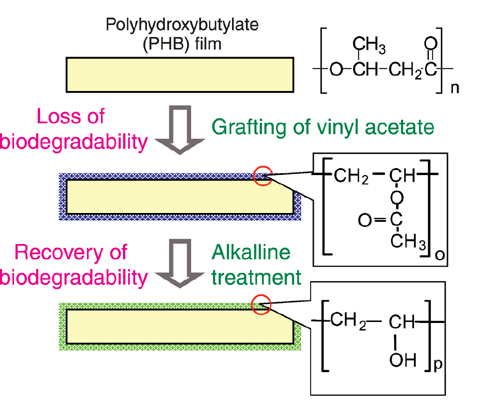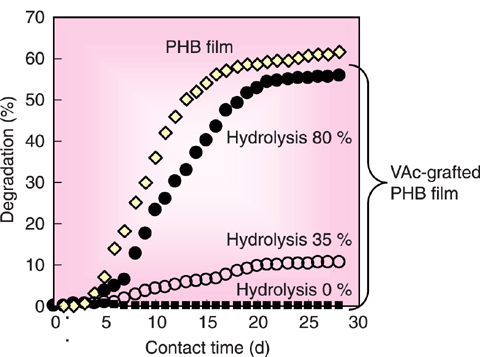
Fig.4-21 OFF-ON control of biodegradability in PHB by graft polymerization

Fig.4-22 Effect of hydrolysis on biodegradation of PHB film grafted by VAc
Biodegradable plastic is attractive as an environment-friendly polymer, which is finally decomposed, to water and carbon dioxide in the ground. In Japan, 6,000 tons of biodegradable plastic, 10% of world consumption, is used annually. Polyhydroxybutylate (PHB) is biodegradable polyester, which is accumulated in the bodies of microorganisms. Though its mechanical strength is the same as that of polypropylene, PHB was rapidly degraded by native microorganisms even in anaerobic conditions. Thus, it has the ideal features of a biodegradable polymer, maintaining its mechanical strength like non-biodegradable plastic during use and having its biodegradability induced after disposal by chemical treatment.
Graft polymerization can introduce a polymer chain onto a trunk polymer, as in grafting for trees. In radiation-induced grafting, the active sites in the trunk polymer are produced with electron beams (EB) and γ-rays and reacted with a polymerizable reagent, so that the graft chain propagates. When vinyl acetate (VAc) was grafted on EB-irradiated PHB film, a layer composed of polymeric VAc chains covered the PHB film as shown in Fig.4-21. Although PHB is biodegradable polymer, its biodegradability was lost by the overlay of non-biodegradable poly-VAc , which became 15% of PHB weight. Fig.4-22 shows the biochemical oxygen demand (BOD) of PHB film and VAc-grafted PHB films after various degrees of hydrolysis by alkaline treatment. The VAc-grafted PHB film did not exhibit any biodegradation at all. However, alkaline treatment hydrolyzes the grafted poly-VAc on the surface layer of PHB, changing the poly-VAc to biodegradable polyvinyl alcohol. As a result, VAc-grafted PHB recovered its biodegradability after alkaline hydrolysis. Hydrolysis of 80% of the poly-VAc resulted in the same level of biodegradability as that of the original PHB. Hence, the combination of graft polymerization and alkaline hydrolysis could realize the OFF-ON control of biodegradability. This technique will be applicable to a variety of biodegradable polymers in the future.